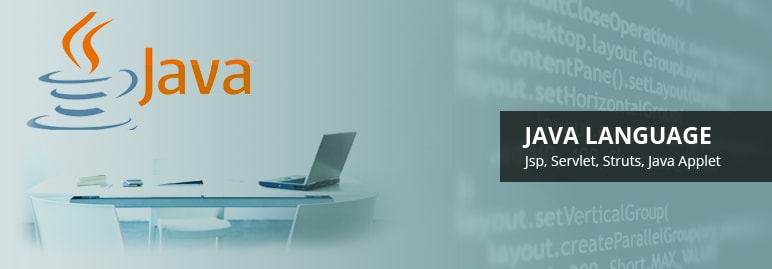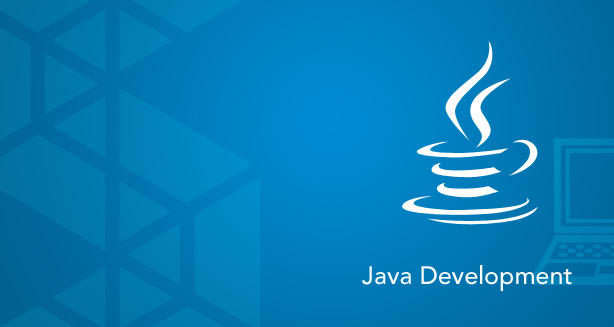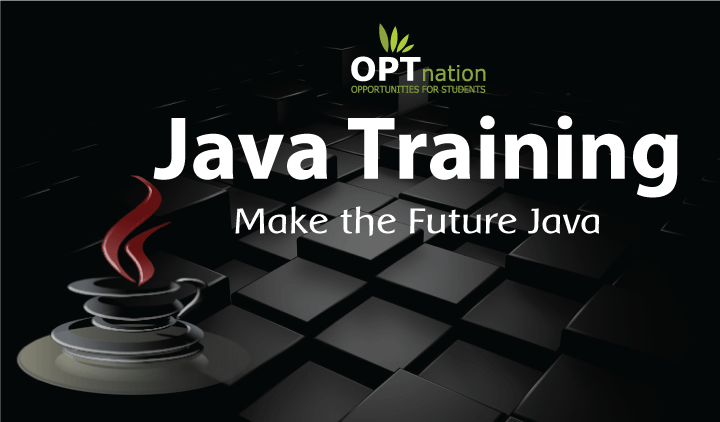❯ What is Java?
Java is an object -oriented programming language and is a platform too. It is simple to understand and is a general purpose language. It was developed by Sun Micro-systems and was later overtaken by Oracle Incorporation. The latest version is Java 8. It is the most powerful and dynamic programming language being used today. This language evolved from Oak language. It includes a wide range of topics which are easy to understand for even those who are less familiar with this language. It is used in a wide range of devices like mobiles, robotics, web applications, games, enterprise applications (banking sector), etc. The APIs (Application Programming Interfaces) for the Java include core java, advanced java, struts, J2EE, JAVA web services, etc.
It is called platform because Java has its own Runtime Environment (JRE) and Application Programming Interfaces (APIs). Today, around 3 billion devices run Java. It powers games, medical devices, ATMs, parking payment stations, lottery terminals, and much more. It is everywhere, it is on desktop, it is on mobile, it is on card, almost everywhere and so are Java programmers. The APIs for Java include core Java, advanced Java, Java Platform Enterprise Edition (J2EE), Java Platform Standard Edition (J2SE), and Java Platform Micro Edition (J2ME).
❯ Key features and benefits of Java Training
- Most widely used programming language in the world
- For beginners, this course provides a comprehensive training, including Java fundamentals
- Understand what is Java and from scratch
- Develop applications for enterprises, mobile phones, and Web
- This course covers the intermediate and advanced Java programming training

❯ Course Objectives of Java Training
After the completion of this course, you should be able to
- Implement exception handling
- Use built-in JSP objects
- Implement multi-threading
- Develop Web applications
- Develop codes using the various Java data types, loops, and conditions
- Implement SOA using Web services
- Write a code in JDBC
- Write a code with Spring framework components
- Understand OOPs
- Use parse XML files
- Develop secured, versatile, and portable applications to be used in critical environments
- Implement performance-oriented Java applications
- Gain expertise in Java servlet technology, REST and Restful services, JSON processing, SOAP, designing, Websockets, APIs, enterprise Java beans, JPA, etc.
- Use exceptions to handle Runtime errors
- Access and manipulate information in relational databases from Java programs
- Use interceptors to assist in programmatic data validation
- Gain the solid working skills in point-to-point and publish subscribe messaging
- Work with different JMS message types
- Orchestrate Web services
- Monitor SOAP messages between web services and clients
- Develop and deploy message-driven beans to process queued messages asynchronously
- Work with Hibernate configuration file
- Work with Hibernate queries, HQL, and criteria
- Understand the basic philosophies of Spring
- Understand the basic philosophies of Spring
- Configure beans in a Spring configuration file
- Effectively utilize the aspect support of Spring
- Understand how to integrate the Spring framework with JEE and Web Services
>>> Register for Java Training <<<
❯ Who should do this course?
Java is a must to hit the programming experts and to kick start your career. Following people can opt this course without any second thought.
- Professionals aspiring to become a Java programmer
- Web developers, Web designers, programmers, and database administrators looking to hit the market
- Freshers/graduates with no prior experience in Java programming
❯ Pre-requisites
- Basic knowledge of variables, flow control, functions, etc. is required.
- Earlier experience in programming is must.
- Prior knowledge on OOPs will prove beneficial, but not required necessarily.
❯ Course Content

Module 1 : HTML
- Basics of HTML
- Layout
- Navigation
- Interactivity through forms
- Links, graphics, lists
- Frames, tables, navigation bars
Module 2 : XML
- Introduction to XML
- Well-formed XML
- XPATH
- XSLT
- XSD
- SOAP
- WSDL
- XML-DOM
Module 3 : Introduction
- Types of programming language and paradigms
- Why Java?
- Flavors of Java
- Features
- Java designing goal
- Industrial role of Java programmer
- JVM (Java Virtual Machine) — the heart of JAVA
Module 4 : Java script
- Understanding Java script
- Fundamentals
- Capabilities
- Features
- Benefits
- Limitations
- Data types
- Functions
- Forms
- Objects
- Event, frames, windows
- Decisions and looping
- Dynamic pages
- Error handling
Module 5 : Language fundamentals
- Java environment
- Installation
- Compilation
- Executions
- Java program development
- Java source file structure
>>> Register for Java Training <<<
Module 6 : Basic language elements
- Identifiers
- Literals, comments, and keywords
- Lexical tokens
- Primitive data types
- Arrays
- Condition statements
- Control statements
- Command line arguments
- OCJP
Module 7 : OOP — Object Oriented Programming
- Fundamentals
- Object and object reference
- Constructors
- Method overloading
- Recursion
- Access specifiers and access modifiers
- Design of accessor and mutator methods
- Inheritance
- Inner class and anonymous classes
- Abstract class
- Interfaces
- Cloning objects, shallow and deep cloning
Module 8 : Packages
- Package as access protection
- Import and static import
- Definition of packages
- Classes and interfaces in packages
- Naming convention
- CLASSPATH setting for packages
- Making JAR files for library packages
Module 9 : Exception handling
- The idea behind exception
- Exceptions and errors
- Types of exception
- Control flow in exceptions
- JVM reaction to exceptions
- Use if try, catch, finally, and throw in exception handling
- In-built and user-defined exceptions
- Checked and unchecked exceptions
Module 10 : Multi-threading
- Understanding threads
- Needs of multi-threaded programming
- Thread life cycle
- Creating child threads
- Multi-threads in a program
- Thread priorities
- Synchronizing threads
- Inner communication of threads
- Critical factor in thread deadlock
Module 11 : Input/output operation in Java (java.io package)
- Streams and the new I/O capabilities
- Understanding streams
- The classes for input and output
- The standard streams
- Working with file object
- File I/O basics
- Reading and writing to files
- Buffer and buffer management
- Read/write operations with file channel
- Formatted I/O
- Sequence input
- Random access
- Serializing objects
- Character streams
Module 12 : GUI programming
- Designing Graphical User Interfaces (GUIs) in Java
- Components and containers
- Basics of components
- Using containers
- Layout managers
- AWT components
- Event-driven programming in Java
- Adapter classes as helper classes in event handling
- Anonymous inner classes a short cut to event
- Handling
- Adding a menu to window
- Dialog boxes
- Built-in dialog boxes – FileDialog
- Extending GUI features using swing components
Module 13 : Applets
- Applet and application
- Applet architecture
- Parameters to applet
- Embedding applets in Web page
- Applet security policies
Module 14 : Collections framework and utility classes
- Utility methods for arrays
- String tokenizer
- Observable and observer objects
- Date and time
- Data structures
- Timer and timer task for job scheduling
- Using scanner
- Regular expression
- Collections of objects
- Collection types
- List
- Set
- Sequence
- Map
- Understanding hashing
- Use of ArrayList and vector
- Hashtable and HashMap
Module 15 : Annotations
Module 16 : Assertions
Module 17 : Generics
Module 18 : Reflection
Module 19 : Java SE 6.x/7.x features
>>> Register for Java Training <<<
Module 20 : JSP
- Introduction to JSP
- Introduction to servlets
- Java servlet architecture
- Lifecycle of servlet
- Servlet containers
- Types of servlet containers
- Configuration
- Deploying servlets
- Directives
- Content type
- Buffering
- Scripting elements
- Page translation
- Standard actions
- Implicit objects
- JSP expressions
- Scriptlets
Module 21 : Networking using Java
- Networking essentials
- Socket programming
- Datagrams
- URL
- Multicast sockets
Module 22 : Swings
- GUI application development
- Introduction to swings
- Different swing components
Module 23 : Database programming using JDBC
- Introduction to JDBC
- JDBC drivers and architecture
- DriverManager, connection, statement, and Resultset
- CRUD operation using JDBC
- Prepared statement
- Calling SQL functions
- Database stored procedures
- CallableStatement
- ResultSetMetaData
- DatabaseMetadata
- Connecting to non-conventional databases
- Overview of database driver architecture
- JDBC driver types
- Batch updates
- Scrollable Resultset
- Updated Resultset
- Working with rowsets
- Handling binary data (operation on image files)
- Type mapping and SQL3 data types
- ParameterMetaData
- Using savepoint
- Connection pooling
Module 24 : Servlets
- Need of server side programming
- Comparison with Common Gateway Interface (CGI)
- Architecture and challenges of Web
- Application
- Introduction to servlets
- Servlet life cycle
- Developing and deploying servlets
- Generic servlets
- ServletConfig, servlet context
- ServletRequest, ServletResponse
- Database operation using servlets
- Deploying servlets in apache tomcat server
- Weblogic server
- Exploring deployment descriptor (web.xml)
- HTTP servlets
- Session tracking and management
- Transferring request
- Accessing Web context
- Passing INIT and CONTEXT parameters
- Filtering request and response
- Filter servlets
- Servlet chaining
- Include and forward mechanism
- Internationalization using servlets
- Event listeners in servlets
- ServletRequestWrapper
- ServletResponseWrapper
- Web application security
Module 25 : Java beans
- Component model services
- Java beans properties
- Bean persistence
- Introspection
Module 26 : Java server pages
- Basic JSP architecture
- Life cycle of JSP
- JSP tags and expressions
- Comparison with servlets and JSP
- Scriptlets, declarations, expressions, and directives
- Action tags
- JSP to servlets and servlets to JSP
- Java beans in JSP
- JSP session
- JSP scope
- Custom tags in JSP
- JSTL
Module 27 : Java Web services
- Introduction
- Why Web services
- Web services for Java EE (WS4JEE)
- Scenarios for hosting Web services
- Scenarios for invoking Web services
- The automated approach
- JAX-WS
- JAXB
Module 28 : JAXB
- Manual options
- JAXP
- SAAJ
- Service registries
- JAXR
- Messaging model
- Introduction to namespaces
- SOAP: the simple object access protocol
- Message header
- Message body
- Faults
- Attachments
- Java API for XML binding
- Requirement for binding
- XML schema
- Mapping schema types
- Java-to-XML mapping using annotations
- JACB compilation
- In-memory validation
- Web services description language
Module 29 : Struts framework
- Struts architecture
- Struts classes
- ActionForward
- ActionForm
- ActionServlet
- Action classes
- Understanding struts-config.xml
- Struts flow with an example application
- Use of ActionForms
- Struts tag Libraries
- DynaActionForms
- Built-in actions in Struts
- Struts tiles framework
- Struts validation framework
- Internationalizing Struts application
- Pagination and sorting using display tag
- Hibernate integration in Struts
- Struts2
Module 30 : Hibernate framework
- Hibernate overview
- Benefits
- Configuration
- Working with sessions and persistent objects
- CRUD operations
- HQL — Hibernate Query Language
- Named queries
- Projection queries
- Aggregate queries
- Query by criteria
- Query by example
- Persistent, transient, and detached objects
- Hibernate first-and second-level cache
- Overview of object relationship
- Mapping collections of value objects
- Entity relationships
- 1-N
- N-1
- N-N
- 1-1
- Queries across relationships
- Lazy
- Eager
- Native SQL queries
- Inheritance mapping
- Collection mapping
- Versioning
Module 31 : Spring framework
- Introduction to Spring framework
- Spring modules
- Spring core module
- Spring DAO module
- Spring ORM module
- Spring JEE module
- Spring Web MVC module
Module 32 : SOAP-based Web services
- Defining SOAP messages with WSDL
- SOAP messages structure
- SOAP envelope
- Soap over HTTP
- Role of SOAP Web services
- WSDL basics
- WSDL bindings
- Overview of Apache Axis2
- Introduction to Apache Axis2
- Features of Apache Axis2
- Architecture of Apache Axis2
- Processing model of Apache Axis2
- Simple Web services
- Deploying the service
- Run the client
- SOAP monitor
- Abstract WSDL elements
- Concrete WSDL elements
- Apache Axis2 Web service clients
- Steps to create a client
- Generated code
- Client code overview
- Instantiate the sub
- Compile the client code
- Run the client code
- Set the request parameters
- Apache Axis2 Web service endpoints
- Server code
- Creating the server code
- AAR files
- Steps to edit the skeleton
- Get the parameters
- Writing the business code
- Build and deploy
- Improving generated WSDL
- Annotating Java services
- End points deploying
- Exposing POJOs (Plain Old Java Objects) as Web services implementing code-first Web services
- Choose between WSDL-first and code-first Web services
- Preserving maintainability
- With proxies
- With adapters
- Generation of portable artifacts
- Implementation of Web service clients in Java generating client code from WSDL
- Creation of client source files form WSDL
- Access Web services via their WSDL
- Customize generated source files
- With JAX-WS
- SOAP messages structure
>>> Register for Java Training <<<
Module 33 : JSF
Module 34 : Overview of JSF
- What is model view controller
- Elements of JSF
- xml
- faces-config.xml
- Facelets power
- Features of JSF
- Annotations review
Module 35 : GUI components 1
- Component families
- Lifecycle of JSF
- Output components
- Text
- Labels
- Forms
- Test input
- Passwords input
- Output formatting
- Messages and severity
Module 36 : Navigation
- Rules
- Cases
- Static vs. dynamic actions
- Navigation in faces-config.xml
- Backing beans
- Use
- Lists
- Map properties
- Using the FacesContext
- Action methods
- Managed beans declaration via annotations
Module 37 : Validation and conversion
- Introduction of validation and conversion in lifecycle
- Number conversion
- Standard input validators
- Client-side validation
Module 38 : Events
- JSF phases
- Process validations
- Invoke application
- Process validations
- Render response
- Page actions
- Data model events
- Action events
- Action methods
- Action listeners
- Value change event
- Introduction
- Methods
- Phase events
- Registration
- Specification of requests handled by the Phase listener
- GET vs. POST
- View tree creation
- Rendering the existing view tree
Module 39 : GUI components 2
- Items selection from list
- Data tables
- Interactive data tables
- Display-only data tables
- Panel group
- Panel grid
Module 40 : Page composition using Facelets
- Passing parameters to page
- JSTL and Facelets
- Templating
- Components of Facelets composition
- Using other tag libraries
- taglibs supporting Facelets

❯ FAQs
For how long the Java Course is?
The training course for Java will last for 6 weeks covering concepts of basic Java, Graphics, and Java classes.
What about the payment procedure?
Debit card, credit card, or Net Banking from all the leading banks – any mode of payment suitable to you is acceptable by us. It is simple and step by step follow up is provided at our site. Also for USD payment, PayPal option is available. Not only this, if you have problem in paying it as bulk, we have EMI option for you.
What if I miss a class?
If you miss out to attend a class, you need not to worry, because the session automatically gets recorded which you can access form your account. So you can easily attend the missed class anytime and can re-attend the live lecture in the upcoming Batch.
Do you provide demo sessions?
Although in a live session the number of participants remains limited, we provide demo classes before you enroll. Because our priority is in producing professionals in the Industry, we closely monitor aspects of good teaching and learning, and thus care about your views. So you can attend first two classes for free and then can enroll if satisfied.
Will I be able to download the training content?
Yes. Once you register with OPT NATION, you can download the material easily as the link will be provided on your homepage.
Is online learning effective to become an expert on Java?
Yes, it is. Various benefits online training provides include attending the class anytime and from anywhere, course material is accessible for life time, immediate doubts clarification with experts of the industry, and saves time and expense. With less input, you can achieve more and more.
Do you provide placement assistance?
OPT NATION is the largest online education company and lots of recruitment firms contacts us for our students profiles from time to time. Since there is a big demand for this skill, we help our certified students get connected to prospective employers. But we do not guarantee the placement, as it ultimately depends on your hands-on experience and how diligently you have completed your project work.
What if I have more queries?
Our support team is available for you 24*7*365. Your queries will be answered by our experts anytime you need. Even after the completion of the course, you can avail the benefit of re-attending the missed session as you are a lifetime member of OPT NATION.
How do I get my certificate?
After successful completion of the course and related assignments, exercises and exams, your certificate will be emailed to you.
What if I fail to clear my certification course in first attempt?
You can anytime ask for assistance to your queries and doubts and reappear for the certification exam. Once you have enrolled, you are a lifetime member and so you will be charged nothing for reappearing. Our experts are here to help you out in all possible ways.
>>> Register for Java Training <<<

